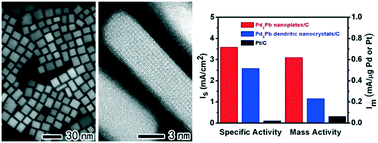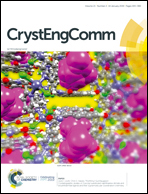Intermetallic Pd3Pb square nanoplates as highly efficient electrocatalysts for oxygen reduction reaction†
Abstract
Pd is generally regarded as an alternative catalyst material to Pt for the oxygen reduction reaction (ORR). However, its catalytic activity and durability are much lower than those of Pt. Here, we report a facile approach for the synthesis of intermetallic Pd3Pb square nanoplates enclosed by {100} facets. The use of oleylamine (OAm), oleic acid (OA), and 1-octadecene (ODE) played important roles in the formation of the Pd3Pb intermetallic square nanoplates in high-quality. The Pd3Pb square nanoplates exhibited substantially enhanced ORR properties in terms of activity and durability. In particular, such nanoplates showed higher mass activity (0.62 mA μgPd−1) and specific activity (3.59 mA cm−2), which were 10.3 and 32.6 times higher than those of the commercial Pt/C, respectively, due to ligand and geometry effects. Significantly, the Pd3Pb square nanoplates/C were highly stable with 23% loss in specific activity and 21% loss in mass activity after 10 000 cycles compared to the Pd3Pb alloy dendritic nanocrystals/C (over 50% loss in specific and mass activities) due to their unique intermetallic structure with high chemical stability.



 Please wait while we load your content...
Please wait while we load your content...